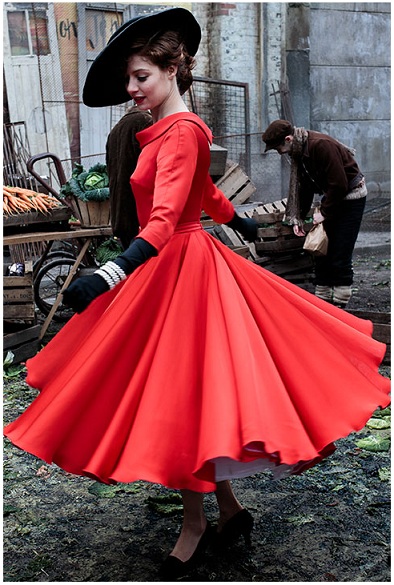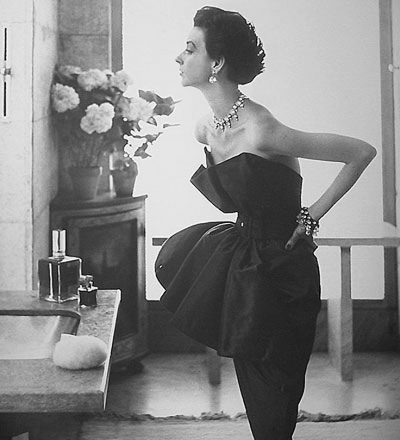
This story was originally published in the literary journal, Vestoj, The Platform for Critical Thinking on Fashion, and depicts a scene that occurred in March, 1947, which is also featured in the tv series, The Collection. It was my first fiction publication!
RED PETALS
Paris, March 1947
I have designed flower women. – Christian Dior, February 1947
Caroline leaned toward the mirror and patted her black hair, sprayed to a stiff sheen. She had imagined this day since donning her first party dress at age five, which had been white with a red sash. She’d spun, thrilling to the rush of air tickling her legs and the fall of cotton gently brushing down, and turned her head to see her inky hair curling on the sleeve.
Now her reflection: her arm a white arc, her cheekbones high and sharp, collarbones gliding into bare shoulders above a tight bodice and a blossoming skirt in luscious, ripe-cherry red.
The joy of feeling pretty washed over Caroline like a clear, rolling wave.
Her heels clicked past girls whispering as makeup was dabbed on their faces. A redhead stared upward as a woman stuck pins into the hem of her emerald dress. Another girl in a white girdle and bra lifted her arms into layers of white tulle. The room hummed with hairspray shushes, compact snaps, and the rustle of skirts.

As she glided through dashes of color and whiffs of perfume, powder and sprays, Caroline remembered her “good dress” during the war, a blue and white plaid that had faded and tightened as her figure bloomed.
A memory surfaced of a Nazi officer’s wife she and her mother had seen one day emerging from Hotel Crillon, with blond hair swept back from haughty eyes. A square neckline smoothed down in black silk to a skirt tight over angular hips. She’d had a cold, diamond-cut beauty.
“Dior,” Maman snapped. “Designer for Lelong; he dresses Nazi wives.” Her eyes narrowed. “His sister, Ginette worked for the Résistance and was taken to Ravensbrük. Dior dresses the enemy while his sister risked her life for France. ”
Caroline stared at the woman and wished she could dress like that.
 After the Liberation, Maman had said Dior had been given sixty million francs to set up his house of couture on Avenue Montaigne, where Caroline and her friends peered into the windows at skirts like opened umbrellas.
After the Liberation, Maman had said Dior had been given sixty million francs to set up his house of couture on Avenue Montaigne, where Caroline and her friends peered into the windows at skirts like opened umbrellas.
The name Dior echoed with a new respect, of fabric pulled generously out of a bolt with a thump- rustle- thump, the slow cush-and-clip of scissors, of hushed gasps and quiet applause. The New Look.
One afternoon in January 1947, a man in spectacles and a gray suit sidled up to Carolyn as she stood outside Dior’s shop, nose against the glass, and asked her if she’d ever considered modeling.
“We could train you in a few months,” he said.
One March evening at dinner, she’d announced she’d been invited to model at a photo shoot in Montmartre, one of several Dior planned on the streets of Paris to show life after the war. She would be paid sixty francs. After her father sputtered, he’d given permission. Maman smiled indulgently.
“I’m pleased for you, Caroline.” Her mouth tightened, “But, Dior! Those dresses take a lot of fabric, a wasteful crime after such scarcity during the war; people are furious.”
But now the war was over and it was Carolyn’s turn.
*****

Caroline knew Maman and her friends were outside in drab coats and thick brown stockings, whispering and pointing at the American photographers.
When Maman saw her she’d blush scarlet.
She took a deep breath and walked out into chilled, early spring air. A breeze stirred her skirt against the back of her knees, and her spirit fluttered. Sunlight made a spotlight on the sidewalk, lined with cameramen and the curious.
She raised her head. This was her moment. As she walked, her dress ballooned out; she floated on a soft cushion of red.
Caroline felt a tug at the hem of her dress; perhaps a little girl dreaming of Someday.
She spun around into eyes filled with hate.
The tug became a pull. Jolt. Yank. She fell; her hip smacked the cobblestones, stinging. She was attacked from all sides by fingers reaching, clutching, grabbing.
Her body was slapped and spun by calloused hands, her hair snatched and twisted by the angry women of Montmartre. A rag doll ripped apart, she heard one word hissed above curses and exertions:
“Waste!”
She felt a rip vibrate through her being, saw strips of cloth brandished with victorious cries. More hitting, scratching, clawing at her thighs.
Carolyn lay alone on the sidewalk in silence. She crossed her arms around her naked torso and curled up.
She saw torn bits of red, like petals, scattered on the gray stones. A flashbulb popped.

The street sank into an uneasy silence; and then, with a shriek of outrage, a woman stall-holder hurled herself on the nearest model, shouting insults. Another woman joined her and together they beat the girl, tore her hair and tried to pull her clothes off her.
– Excerpt from Paris After the Liberation 1944-1949 by Antony Beevor and Artemis Cooper, Penguin Books, London, 1994
